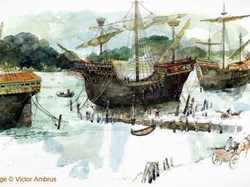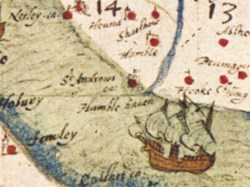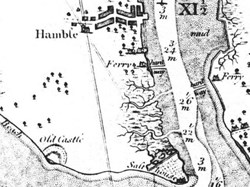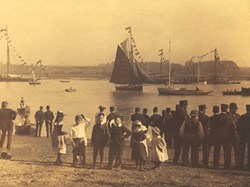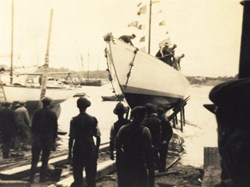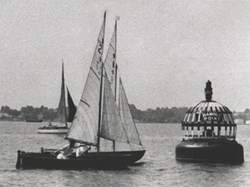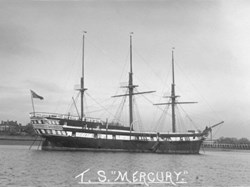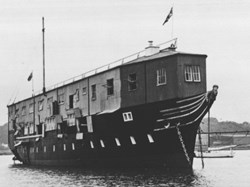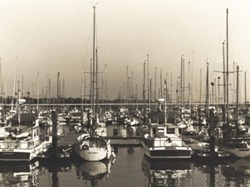Maritime Hamble
As can be seen from the ‘Hamble History’ section much of it is connected with maritime matters. In this section these are noted again or expanded, as well as adding further maritime history.
The earliest mention of Hamble is by the Venerable Bede when he wrote in his Ecclesiastical History about 720 AD "... the tides meet and oppose one another beyond the mouth of the River Homelea (Hamble) which runs into that narrow sea from the land of the Jutes ..." Even in those early days Hamble and its river, particularly the double high tides, was considered an important feature. Also about this time Saint Willibald, a monk educated at a monastery in Bishops Waltham, set sail from the Hamble River for the Middle East.
As early as the 13th and 14th centuries, records show Hamble as a significant maritime centre. In 1235 it is recorded that 11 ships from the Suffolk village of Dunwich, which were full of herring, were arrested at Hamble for failing to pay custom duties. Also the Prior of Hamble used to send annually 20,000 oysters to the monks at Winchester.
At the beginning of the Hundred Years War, Hamble provided provisions for part of the English Fleet in 1339. It is also recorded that, for the Battle of Crecy in 1346, Hamble supplied 7 ships and 117 mariners. By comparison, Portsmouth contributed 5 ships and 96 mariners.
Hamble was used by Henry V’s ships, as Southampton was the main centre for the royal fleet from where in 1415 they sailed to France for the Agincourt campaign. In 1417 twelve royal ships spent the winter anchored at Hamble protected by 40 archers.
In 1418 the ‘Grace Dieu,’ the largest ship ever built in England at that time, was brought to Hamble for fitting out. Her Southampton builder, William Soper, had two storehouses in Hamble and had erected a wooden tower at the river entrance for protection against French raids. During the 15th century many royal ships used the river and a number of them were laid up here. The wreck of the ‘Grace Dieu’ lies in the river mud to this day and another of Henry V's great ships the 'Trinity Royal' was laid up and ended her days at Hamble.
Hamble came under the jurisdiction of Southampton at this time and the Port Books of Southampton and the Admiralty Court Books give an insight into the maritime life during this period. For example, between 1435 and 1450 custom duties were collected at Hamble on fish, oils, hides, skins, cloths and wine.
John Leland’s itinerary 1535-43 describes Hamble as a good fishing town and the river as a very fair rode for great ships. He also records the ferry from Hamble to Warsash.
The village continued to be a maritime centre during the following centuries. We know more about the Hamble/Warsash Ferry from the records of the Admiralty Courts which give a reasonable picture of the activities of local inhabitants. These courts were held on the foreshore with Hamble being one of the designated places, and everyone of any importance in connection with the river was summoned to attend. They dealt with items such as the maintenance of causeways and hards, the operation of local ferries and illegal fishing. An important concern was the protection and removal of obstructions to navigation. Even smuggling and piracy are mentioned.
St Andrew's Castle on Hamble Common was built about 1543 to protect the river and Southampton Water and was part of Henry VIII's Solent defences. One of its governors, Sir Henry Mainwaring, was himself a reformed pirate.
Moody Janverin, a master shipwright and merchant ship builder who lived at Hamble House, built a number of ships at Hamble including the ‘Lively’ for the Royal Navy in 1756. He also built ships for the Royal Navy at Bursledon and Lepe.
Hamble’s location next to the river has made it a natural place for smuggling over the years. Hamble was one of the first places to have 10 dragoons stationed in the village from 1723. A Hamble man called Sturgess, operated as a successful smuggler in the 18th century heyday. By 1783, he had sufficient funds to build a new 20 gun cutter, called ‘Favourite’.
A map of 1698 shows salt pans at Hamble Point and another of 1783 shows a salt house and ponds in a similar position. Salt was an important commodity and a tax was placed on it and Hamble had its own Salt Officer to ensure these were paid.
An indication of Hamble’s nautical activity in the 19th century is a newspaper report of September 1842 which stated that in that year Hamble had already supplied the metropolitan markets with 90,000 lobsters and crabs. It did not mention the produce from the local oyster beds which also provided the fishermen with an income. (Click here to see a similar newspaper article of 1883)
Regattas at Hamble can be traced back to 1868. At that regatta there were sailing races for pleasure boats and fishing boats, as well as races for rowing boats and punts. Similar to most other Hamble regattas, there was a band in attendance and the event finished with a fireworks display. Subsequent regattas also had aquatic events and a fair. In 1961 the Hamble River Regatta was renamed Hamble Regatta & Carnival and in 1997 this became Hamble Week. (Regatta report 1868)
Lukes yacht and boat builders moved to Hamble in the late 1880s, and soon became based at Back Street (now Rope Walk) with building sheds, slipways & yacht stores. At the beginning of the 1900s Hamble Point was used as its winter slips. The Luke Brothers built all sizes of yachts and produced the Hamble One Design. In the 1920s Lukes developed another boatyard off Satchell Lane, known as Top Yard (or North Yard), which is now Hamble Yacht Services. In 1925 Lukes designed and built the Hamble Star sailing dinghy which became a popular racing dinghy with the local sailing club. Lukes were taken over by Port Hamble during the Second World War.
Because of its maritime advantages and the skills that were available, Hamble attracted the fledgling aviation industry, especially seaplanes. Even Lukes tried to develop its own seaplane. During the First World War two large aviation companies, Avro and Fairey Aviation came to Hamble to establish factories. Fairey Aviation set up at Hamble Point and soon developed the Hamble Baby seaplane. This was followed by Fairey’s more famous inter-war seaplanes, many of which were exported abroad.
In preparation for the First World War the Admiralty moored old naval vessels off Badnam creek and a large battleship mast (from HMS Sultan) was placed in the mud at the entrance to the creek. This was part of the Admiralty’s boom defence initiative to protect Southampton Water.
Hamble had its own nautical training school known as TS Mercury. This was founded in 1885 by Charles Hoare to train boys for the Royal and Merchant navies and it became permanently based at Hamble in 1892. A shore establishment was built and a training ship moored on the river. In 1908 the famous scholar and sportsman CB Fry became the principal and, together with his wife, ran the school for 42 years. Students endured a tough regime to prepare them for a career at sea, but they also enjoyed sporting and other activities. Unfortunately, because of financial difficulties, the school closed in 1968.
Another significant industry that came to Hamble was oil storage and distribution. Originally a ship named 'British Maple' was moored in Southampton Water off Hamble Common as a floating storage facility. By the mid 1920's an oil terminal and jetty had been built and during the Second World War the PLUTO oil pipeline to the D-Day beaches passed through the terminal. Large sea going tankers continue to transport oil products to and from Hamble.
During the Second World War the river was closed to the public and many Admiralty small boat activities took place. At Hamble the Parish Foreshore was filled in with rubble from blitzed Southampton and the U.S. Army Transportation Corps Water Division built a repair depot in preparation for the D-Day landings. Lukes maintained the Solent Patrol for the Royal Navy and built landing craft.
After the war Fairey Aviation at Hamble Point found it had to diversify so set up Fairey Marine. It started by producing the Uffa Fox designed Firefly sailing dinghy which was used in the 1948 Olympics, followed by many other dinghies such as the Duckling, Albacore & Jolly Boat. Using its own hot moulding process it could produce large numbers of identical boats to a good quality and price. During the 1950s it was one of the biggest boat builders in Europe. Fairey Marine went on to produce its famous powerboats such as the Fairey Huntsman.
At the beginning of the 1960s, the Fairey Huntsman and other Hamble powerboats were at the forefront of powerboat racing. Bruce Campbell produced the Christina and Port Hamble the Pacemaker.
In 1889 the Minima Sailing Club was formed in Hamble and it was based at Hamble Point. Following this a number of other sailing clubs were based at Hamble before First World War. In 1919 local residents formed the Hamble River Sailing Club, which went on to provide six of the thirteen man Great Britain Olympic Sailing Team in 1972 and they brought back a Gold and Silver medal. The Royal Southern Yacht Club came to Hamble in 1936 and was the challenging Club when it entered ‘Lionheart’ in a bid to win the 1980 America's Cup. The Royal Air Force Yacht Club transferred from Calshot to Riverside House in 1952.
Hamble was also at the forefront of the development of marinas. Port Hamble Marina was one of the first to be opened in this country in 1964, followed by Mercury Marina in 1971 and Hamble Point Marina was constructed in 1973. This provided a more efficient way of mooring boats in crowded harbours and many boat owners found them more convenient.
In 1969 local residents started an inshore rescue service, now known as Hamble Lifeboat. The following year, Hampshire County Council took over control of the river from Southampton Harbour Board.
Fairey Allday built ‘Victory 83’ for an America’s Cup campaign, just before the Fairey company closed at Hamble Point in 1983. Cougar Marine took over the works to build powerboats including ‘Atlantic Challenger’ in an attempt to break the Atlantic crossing record. They also built a twelve metre yacht, ‘Crusader’, to challenge for the 1987 America’s Cup. In 1990 classic yacht restorers, Fairlie Restorations, started work at Port Hamble.
Throughout the 20th century Hamble developed into one of the country's leading yachting centres and many famous yachting personalities have used it facilities or been based here. Today there are many kinds of boats on the river and a wide range of marine servicing industries have been developed for them. Maritime Hamble importance continues into this new century as it has in the past.
© Ian Underdown 2009
